The AMD Radeon R9 290 Review
by Ryan Smith on November 5, 2013 12:01 AM EST- Posted in
- GPUs
- AMD
- Radeon
- Hawaii
- Radeon 200
Compute
Jumping into pure compute performance, this is another scenario where the 290X shouldn’t throttle as much, and as such the performance differences between the 290 and 290X should be closer to what they are on paper. With compute workloads the ROPs aren’t being hit hard, so that’s power and thermal savings that lets both cards operate at close to their maximum boost clocks.
As always we'll start with our DirectCompute game example, Civilization V, which uses DirectCompute to decompress textures on the fly. Civ V includes a sub-benchmark that exclusively tests the speed of their texture decompression algorithm by repeatedly decompressing the textures required for one of the game’s leader scenes. While DirectCompute is used in many games, this is one of the only games with a benchmark that can isolate the use of DirectCompute and its resulting performance.
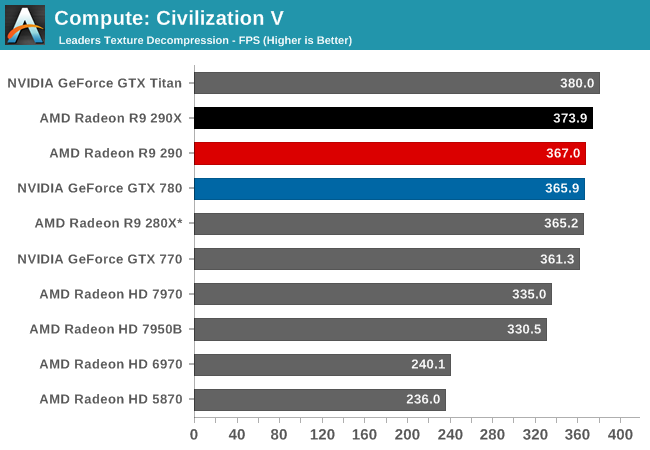
As with the 290X, Civ V can’t tell us much of value due to the fact that we’re running into CPU bottlenecks, not to mention increasingly absurd frame rates. The 290 is marginally slower than the 290X due to the lower clockspeeds and missing CUs, but minimally so.
Our next benchmark is LuxMark2.0, the official benchmark of SmallLuxGPU 2.0. SmallLuxGPU is an OpenCL accelerated ray tracer that is part of the larger LuxRender suite. Ray tracing has become a stronghold for GPUs in recent years as ray tracing maps well to GPU pipelines, allowing artists to render scenes much more quickly than with CPUs alone.
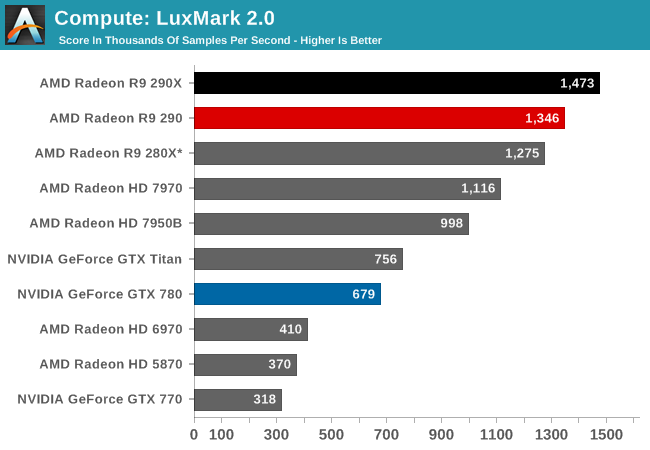
With both cards unthrottled and bound solely by shader performance, it’s an outright foot race for the Radeon cards. 290 trails 290X by around 9%, closely mirroring the difference in the CU count between the two cards. Though 290 is being very closely chased by the 280X, as Hawaii in general seems to have trouble getting the most out of its shader hardware on this benchmark.
Our 3rd compute benchmark is Sony Vegas Pro 12, an OpenGL and OpenCL video editing and authoring package. Vegas can use GPUs in a few different ways, the primary uses being to accelerate the video effects and compositing process itself, and in the video encoding step. With video encoding being increasingly offloaded to dedicated DSPs these days we’re focusing on the editing and compositing process, rendering to a low CPU overhead format (XDCAM EX). This specific test comes from Sony, and measures how long it takes to render a video.
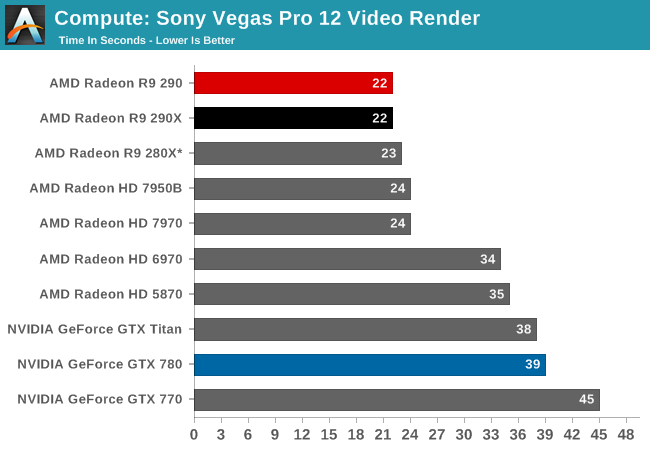
There’s not enough of a GPU performance difference between the two cards to matter with this test. Both tie at 22 seconds.
Our 4th benchmark set comes from CLBenchmark 1.1. CLBenchmark contains a number of subtests; we’re focusing on the most practical of them, the computer vision test and the fluid simulation test. The former being a useful proxy for computer imaging tasks where systems are required to parse images and identify features (e.g. humans), while fluid simulations are common in professional graphics work and games alike.
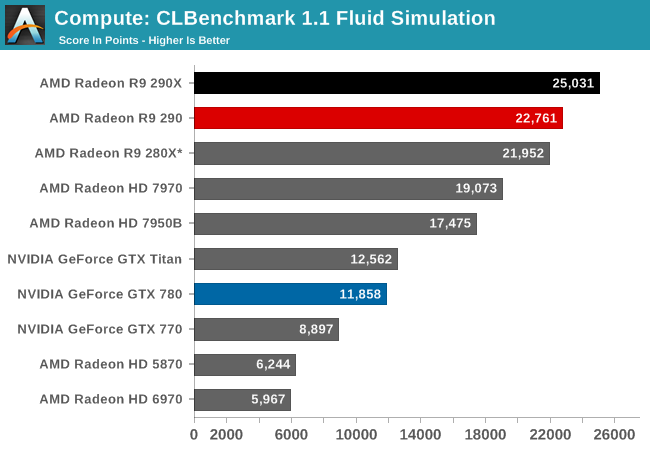

In the CLBenchmark fluid simulation the 290X and 290 take the top spots as expected, with the 290 trailing once more by 9%. However both Hawaii cards are still struggling with the computer vision benchmark, leading to the 290 being edged out by the 7970 of all things.
Moving on, our 5th compute benchmark is FAHBench, the official Folding @ Home benchmark. Folding @ Home is the popular Stanford-backed research and distributed computing initiative that has work distributed to millions of volunteer computers over the internet, each of which is responsible for a tiny slice of a protein folding simulation. FAHBench can test both single precision and double precision floating point performance, with single precision being the most useful metric for most consumer cards due to their low double precision performance. Each precision has two modes, explicit and implicit, the difference being whether water atoms are included in the simulation, which adds quite a bit of work and overhead. This is another OpenCL test, as Folding @ Home has moved exclusively to OpenCL this year with FAHCore 17.
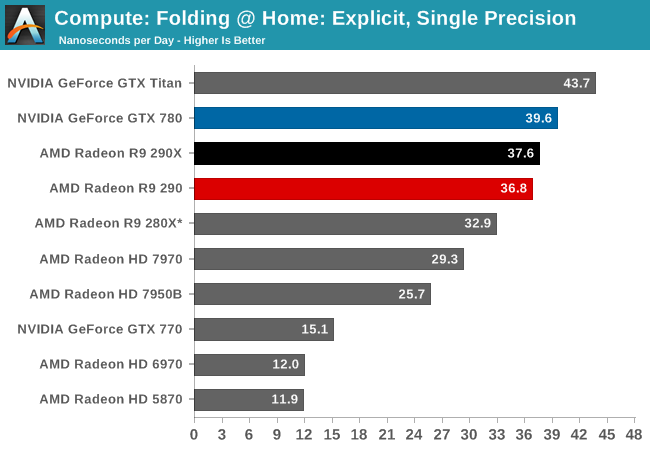
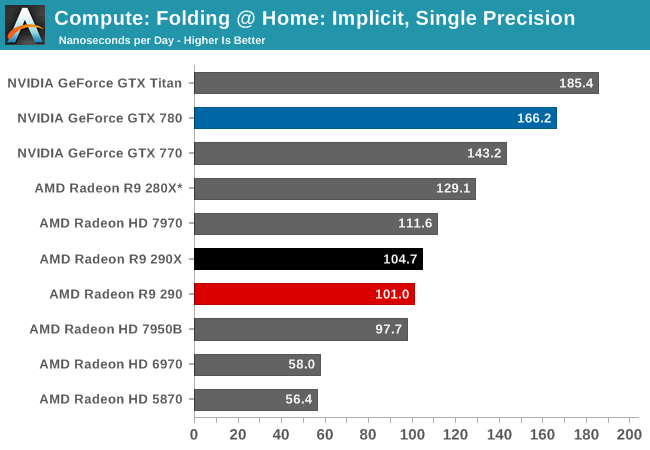
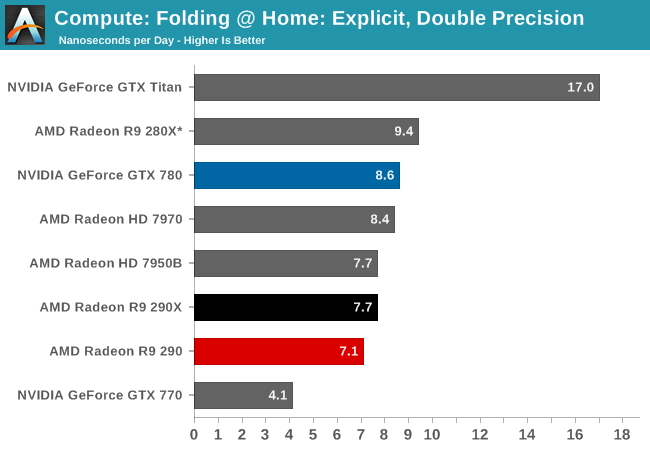
Generally Tahiti and Hawaii are strong performers in the GPU compute arena, but that isn’t of particular help to the 290 here, as it loses out to the GTX 780 in every mode. In single precision FAHBench has trouble putting Hawaii to good use at times, while double precision tests have the 1/8th DP rate 290 and 290X falling behind due to their lower than Tahiti DP throughput.
Wrapping things up, our final compute benchmark is an in-house project developed by our very own Dr. Ian Cutress. SystemCompute is our first C++ AMP benchmark, utilizing Microsoft’s simple C++ extensions to allow the easy use of GPU computing in C++ programs. SystemCompute in turn is a collection of benchmarks for several different fundamental compute algorithms, as described in this previous article, with the final score represented in points. DirectCompute is the compute backend for C++ AMP on Windows, so this forms our other DirectCompute test.
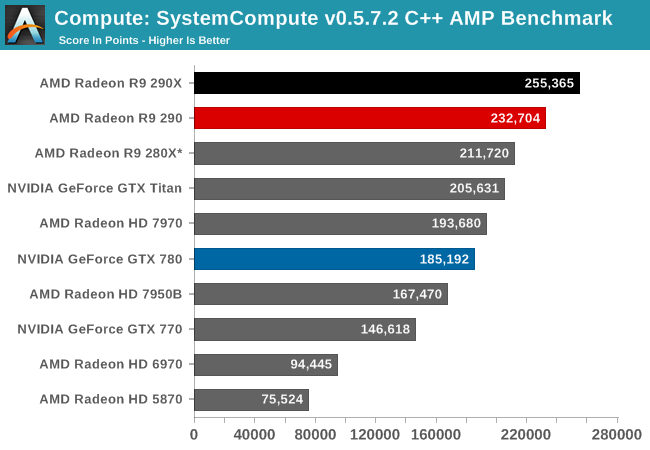
SystemCompute is another benchmark where 290 and 290X do not experience meaningful throttling, and as such are separated by more than what happens in our gaming benchmarks. In this case 290 yet again trails 290X by 9%, though it still enjoys a considerable lead over the GTX 780 and all other NVIDIA cards.










295 Comments
View All Comments
dragonsqrrl - Tuesday, November 5, 2013 - link
Fanboism? I know right?EJS1980 - Tuesday, November 5, 2013 - link
He was referring to you, and you know this.Mondozai - Friday, December 13, 2013 - link
EJS1980 the buttboy for Nvidia has spoken!JDG1980 - Tuesday, November 5, 2013 - link
Well, what the review fails to take into account is that for the vast majority of the card's lifetime, all or nearly all the cards actually sold will be using third-party coolers which are much better than AMD's halfhearted effort. All the noise measurements are completely irrelevant once Asus and MSI get their hands on the silicon and start releasing custom cards.A5 - Tuesday, November 5, 2013 - link
They can't review a card they don't have. I would think they will do a 290 round-up once some of the custom designs come out.Spunjji - Tuesday, November 5, 2013 - link
Quite right. This is a perfectly fair review.dragonsqrrl - Tuesday, November 5, 2013 - link
And then there's the disturbing revelation on Tom's that retail cards are underperforming AMD's reference review cards by a significant margin. But it's AMD, so it's okay.I mean seriously, could you imagine the uncontrollable outrage there would be if Nvidia tried to pull something like this? There would be an uproar from the community unlike anything the interweb's seen before. But if it's AMD? Largely silence, driven by either indifference (AMD fanboys), or AMD fanboy appeasement (confrontation averse reviewers). We wouldn't want to directly oppose the AMD fanboy agenda, lest we have to deal with yet another uproar from AMD's zealous fan-base, which occurs whenever a reviewer says anything remotely negative yet entirely relevant about an AMD product (Bulldozer, HD6990, R9 290, etc...)
just4U - Wednesday, November 6, 2013 - link
I've been watching this battle since the Radeon 8500 Geforce 3 days.. and to be absolutely honest with you.. don't matter what amd or Nvidia does fanboys will rage against the rival. It's the way they are... (shrug)Both companies have had their fair share of tricks btw.. (just in case you didn't know that or had forgotten)
dragonsqrrl - Thursday, November 7, 2013 - link
Uh, definitely haven't forgotten, otherwise there would be no context for the vastly different reactions I'm referring to. And honestly dude, I think you and other people who refer to the fanboy situation on both sides being the same are just displaying your own ignorance and unfamiliarity with the situation. I've noticed that despite how bad it can get here, I've never seen it get even remotely close to the norm on Tom's. It's gotten so bad at times (Bulldozer, HD6990, recent buyers guides, etc...) that the authors and reviewers have had to address the AMD fanboy situation directly in forums and comments. To which the zealous AMD fanbase becomes even more enraged, even resorting to malicious personal attacks against Chris, Don, etc, demanding to know why Nvidia/Intel fanboys are never addressed directly in the same way. Well, because they don't behave the same way... lol.When you genuinely believe that any author who doesn't conform to your inherently biased agenda is biased and bought out, and you adamantly defend that belief (over and over again) with childish and at times downright offensive remarks directed at both the authors and other readers, then it's not something that can be ignored. It never ceases to amaze me that despite how often they're thoroughly shutdown, and lose practically every argument they start, they still press on. They just ignore and continue. In fact if anything it seems to give them strength and further cement their delusional beliefs. They're an endless source of astonishment, those AMD fanboys, I'll give them that much.
Homeles - Tuesday, November 5, 2013 - link
From everything I've read, reference cards sell a lot more often than you'd think.